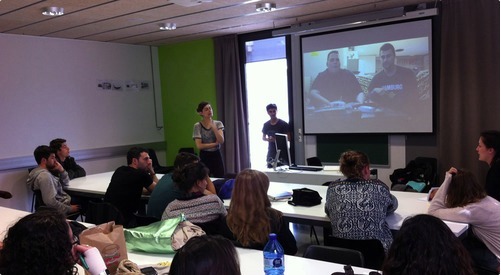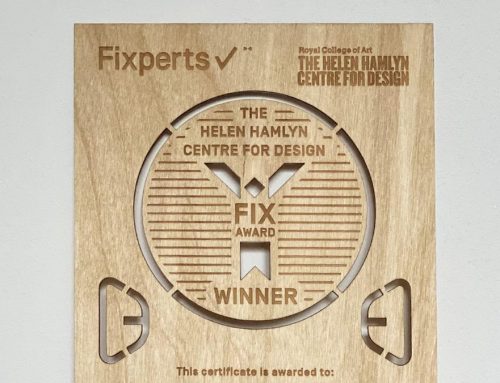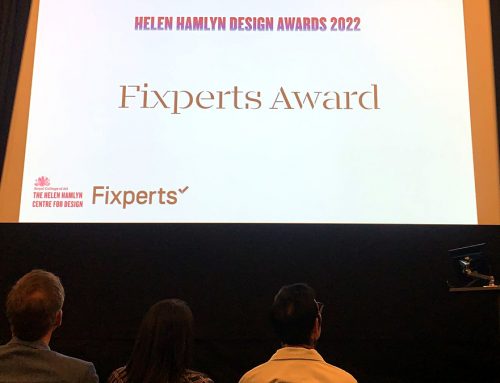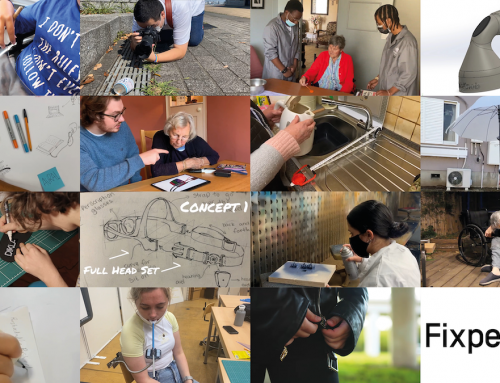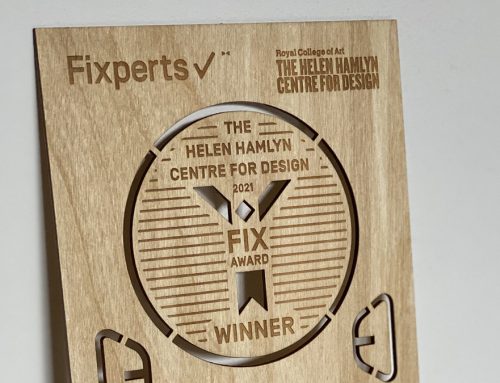When you knock at the door of a design school with the proposal of making a workshop they normally look at you with an odd expression and say they’ll get back to you.
When you knock at a design school’s door with the proposal of making a Fixperts workshop however, they look at you with a special twinkle in their eyes and say: ok, when do we start?
It all started in April when we got study coordinators at Elisava, a design and engineering school in Barcelona excited enough about our proposal to invite us to present our idea for a Fixperts workshop to interested students. What follows is our version of what happened, in ten easy points:
Point 1: Setting up a voluntary workshop for students in April, less than two months until their final exams, is almost guaranteed to fail. To our surprise, a whopping 19 students attended the talk.
To our even further surprise, of the 19 who came 18 decided to join. Word got out in school and three days later there were 32 students who wanted to take part. Crazy!
There is no doubt that from the point of view of education, Fixperts is the kind of really delicious candy: a project with a strong social aim and inclusive process that blends the responsibility of dealing with a user directly affected by a problem with the responsibility of creating a fully functional object to solve that problem.
Point 2: Fixperts is a project that works by great mixing students from different classes, ages and disciplines.
We started working in a conventional classroom, every Friday from three to six pm and with 30 participants from different courses and disciplines: a combination of first, third year and,former design students together with engineering students interested in graphic design or specializing in product design and other first year students who had not decided yet on their specialism.
The first major Fixperts task is to find a Fixpartner. This process can be the easiest and fastest part of the project or the most complicated and tedious. Searching amongst our community’s closest friends and family reduces the risk of dropping out. We all have a relative, a friend or nephew of a former girlfriend’s grandfather who has a problem. In fact, we all have tonnes of problems with which we live from day to day. The challenge here is to learn to read and analyse them.
image
Point 3: It is interesting bringing outside professionals to explain their experiences to complement information teachers may not be able to provide. The issue of recording and assembling the final video was one of ours.
Three Fridays later, with 12 participants less thanks to the final exams, and after an interesting talk in class with Barjau Caterina, a photographer and cinematographer specialised in documentaries, we all had a Fixpartner.
Point 4: It is important to record each of the stages you go through in this initial process. In some cases the fixperts did not record their first talks with their Fixpartner or keep their initial sketches, and in the end they missed these.
Organized in groups of 2 or 3 students and with the introductions of each Fixpartner done, we started developing conceptual mind maps, to analyse the problems of each character and start seeing the different ways in which Fixpartners solve or prevent the problems that hinders their day.
We didn’t design for two weeks. From what is needed at this point was to analyse, understand and empathise.

Point 5: Even more important than what or how the process is being recorded, whether it is by camera, video camera, iPhone or Super 8, is that it has to be recorded HORIZONTALLY. Although this might seem obvious, we promise it is not so.
Once we had analysed and internalized every problem, it was time to start proposing solutions. In each workshop we looked at strong and weak points of the projects and found ways to solve those individually. Pens, pencils, scissors, cardboards, prototypes and various objects began to appear in class.
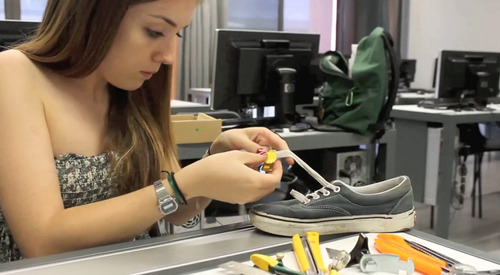
Point 6: In a project like this it is essential to have an end date. Otherwise, curiosity would drag it on for ever. In our case, before beginning we knew that the project had to be completed for July 6 as we were we presenting it with Fixperts co-founder Daniel Charny at the International Open Design Conference in Barcelona.
The final stretch was the hardest. Although we had a joint session each week, it was important that the members developed from week to week and it was also important to be visit the Fixpartner to take notes, make questions and propose solutions. For the students it wasn’t easy to take time off or find the time to develop the project. It was important to keep patient and keep working, understanding and proving that football coaching really does help managing classes and motivating teams be it in sports or in the design world.
Point 7: This point in the project is a good time to invite another external professional to give another point of view other. In this case we were honoured to have the presence of the product designer Jordi Canudas . Gracies Jordi!

And that’s it! Once the storm had passed and proposals began to take shape, it was time to hit the workshop. Luckily Elisava has a very well-equipped workshop for the design and production of small scale objects . Discarding the first ideas, and aiming towards a much clearer and ever-closer horizon, the students began to enjoy the project and their first results showed it. As if by magic, the participants began to play with their hands, building the first prototypes, cutting, gluing, drilling, finding materials, throwing away failed tests. They became fully autonomous, self-motivated, creative – suddenly, they become real FIXPERTS.
Now we just had to record the delivery of objects to each Fixpartner and capture the simple gesture of a smile, to confirm that what we had done was worthy of everyone’s time. The best thing about fixperts is that it is rewarded with a smile.
Point 8: Although people say that making a documentary video is easy and that everyone has the right tools for it, it’s not actually like that. Most of our design students had neither the tools nor the experience or knowledge necessary to develop this process, which is completely understandable. This is where one realises that someone in the film industry is needed to ensure a good project, even at an amateur level, for all the documentation , script writing, editing and art direction involved.
The night before the presentation at Open Design, some videos hadn’t arrived, others were in a portrait format, we had Fixpartners who had not been able to be recorded with the final object, no opening titles, videos that were too big to send via dropbox, etc. Finally, at 3 am we decided to create a joint presentation in which rather than present specific projects, we would explain the development of the workshop. It worked! It was a success! Daniel was happy = We were happy!
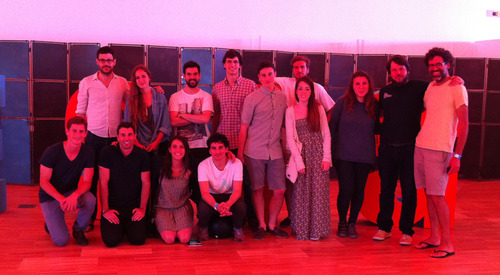
July 6. Barcelona, heat, holidays in sight, festivals, beach, traveling, summer. As a reward for how happy we are and to thank all the students for their effort and dedication, we decided to delay the delivery of the videos until late August, with the intention of uploading them in September.
Point 9: Error! Do not leave for tomorrow what you can finish today …
October 11, 2013. 7 months later we uploaded the 7 projects made by the students of Elisava. An unforgettable experience incredible pleasure and an honour to have shared these months with such wonderful people.

We hope you like and enjoy them.
Point 10: Long live to Fixperts!
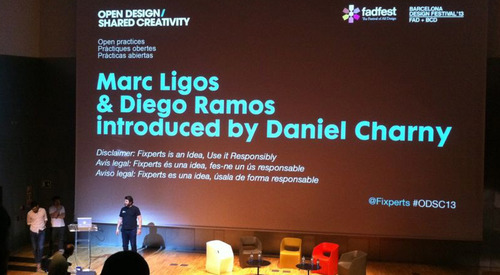
Marc and Diego are design tutors at Elisava, Barcelona School of Design and Engineering (www.elisava.net/en)
Marc Ligos (www.marcligos.com) is a “multitasking” designer who works as theoretical and conceptual researcher, teacher and curator for companies, design institutions and schools.
Diego Ramos (www.diegoramos.es) is a product designer who approaches other directions and design areas teaching and working with professionals across different fields.
Written by Marc Ligos and Diego Ramos

